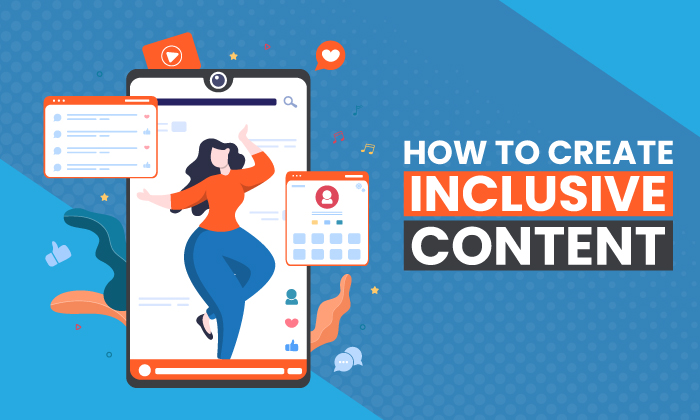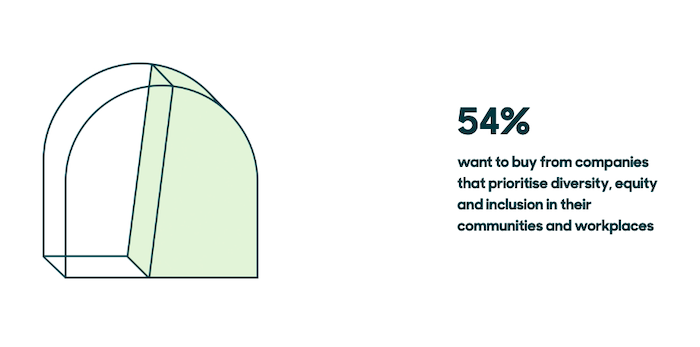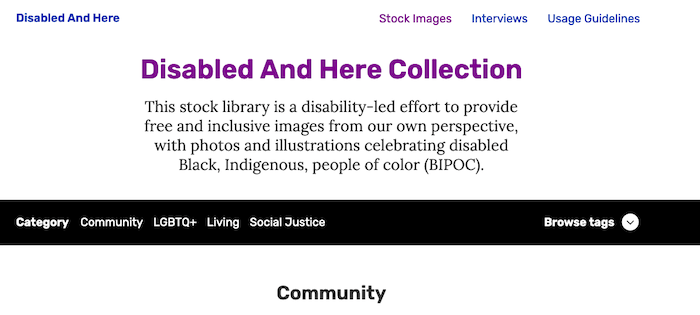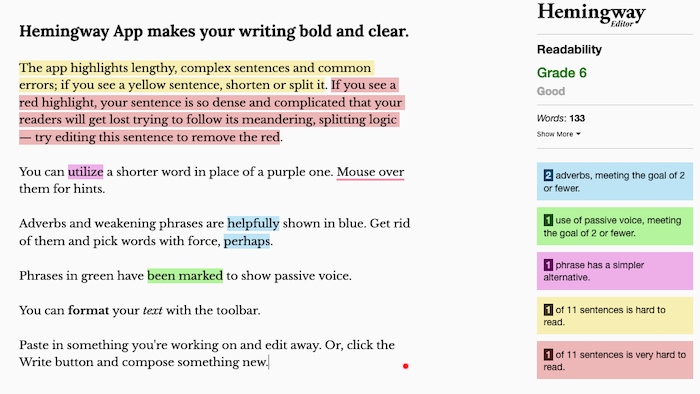
The last thing you’d ever want to do is exclude a person or group of people through your marketing. Yet many marketers and writers have made this mistake.
Divisive and exclusive words and phrases have become so baked into our language that many of us don’t realize when we use them or the harm they cause.
In this article, I’ll explain what inclusive content really means, why you need to be creating it, and how to do it in a meaningful way.
What Does “Inclusive Content” Mean?
Inclusive content is any form of media (such as a blog post, a video, an image, etc.) that speaks to a broad and diverse audience without excluding anyone.
When it comes to blog posts, that means the words do not hurt or divide, the images represent as many different people as possible, and the structure makes the content as accessible as possible (through clear fonts, image alt tags, etc). Inclusive content is NOT a political statement or a personal take on social justice topics.
What Are the Benefits of Inclusive Content?
Let’s be clear; creating inclusive content is the right thing to do. However, there’s a lot more to gain when you write in a way that includes as many people as possible.
For one, it can grow your business. You significantly widen your target markets by opening the door to previously marginalized communities.
At the same time, it raises the profile of your brand with everyone. More than half of consumers want to purchase from companies that prioritize diversity and inclusion, according to a report by Zendesk.

Millennials are even more loyal to inclusive brands. Seventy percent of them will choose a brand that demonstrates inclusion in its marketing efforts.
Inclusive content sells better, too.
The Psychology of Inclusion and the Effects in Advertising by Microsoft Advertising found that the purchase intent of the most inclusive ad in their study was 13 percent higher than the next most appealing ad and 23 percent higher than the average.
Finally, creating inclusive content demonstrates your brand’s commitment to change. Fail to do so, and you’ll look like a brand unwilling or unable to learn or grow (or worse, paint your brand as one that doesn’t care about social issues).
6 Steps to Create More Inclusive Content
Even if you think you already write in an inclusive manner, there’s almost certainly an opportunity to grow. The six steps I’ve outlined below can help even the most experienced content creator to be more inclusive.
1. Look for Blind Spots
Who are you currently creating content for? That should be the first question you ask yourself as you start to write in a more inclusive manner.
While having a target audience may help narrow your focus and improve your PPC campaigns, it won’t necessarily win you any fans when it comes to your content. For one, a customer persona rarely fits every potential customer. If the language and imagery you use only appeals to a specific demographic, you risk alienating potential new customers.
Furthermore, you should use inclusive language and imagery in your content to not alienate your target audience.
The good news is that as soon as you start writing for a wider audience, you’ll suddenly find that your content is much more thoughtful and appealing than any of your competitors. Most marketing efforts still lack diversity and inclusivity, especially when it comes to content marketing. Just identifying and fixing your blind spots can breathe new life into your efforts—and help you build important relationships with a variety of stakeholders.
2. Make Your Content Accessible
How you present your content can be just as important as what you say from an inclusivity standpoint. If you want your writing to be accessible, then you need to start by making your entire site accessible.
Start by making sure screen readers can interact with every page on your site, but especially your blog. Next, make certain the alt text on your images is relevant and not just used to stuff keywords into your article. Screen readers rely on alt text to describe pictures and other visual content.
To that end, captions should also be added to videos. This doesn’t require a huge amount of effort. A tool like Kapwing makes it easy to add captions.
That’s just a start, though. You can do many other things, which I’ve covered in my article on ADA website compliance. These include:
- making sure your website is navigatable by keyboard
- reducing excessive motion in design elements
- ensuring your site doesn’t ignite physical triggers
- improving your website’s color contrast
- making sure your site works with all browsers and accessibility tools
3. Use Inclusive Language
The words you use matter. They have the power to inspire, but they also have the ability to divide and exclude. When it comes to creating inclusive content you have to be careful about the language you choose.
Adopting gender-neutral language should be the bare minimum. Instead of words like “mankind” and “salesman”, use “humankind” and “salesperson.” You should also avoid making gender-based assumptions. Politicians are not always male. A parent is not necessarily a woman. A gender-neutral pronoun like “they” is the safest bet in these scenarios.
For more examples, see the UN’s recent tweet on gender-neutral language.
Inclusive writing often goes beyond gender-neutral language, though. There are plenty of idioms and phrases that seem innocuous on first impression but that actually have harmful and divisive origins. Blacklist and whitelist come from discriminatory metaphors about race, for instance. Similarly, calling people crazy can exclude people with mental or psychiatric disabilities.
Other idioms can exclude people who don’t have the necessary background knowledge. Sport phrases are major culprits here. Using “out for the count” as a phrase wouldn’t typically make sense unless you know about boxing, or are a native-English speaker. A “ballpark figure” can be confusing if you aren’t familiar with baseball.
4. Ask for Audience Input and Additional Help
I mean it when I say creating inclusive content is an ongoing, repetitive process. To that end, you should be having an open and honest dialogue with your audience and other third parties.
The truth is everyone has very different world views, and, ultimately, you don’t know what you don’t know.
As good as these tips are (at least I like to think so), no one gets inclusive writing correct at the first time of asking. So encourage and embrace feedback. The more you discuss your work openly and invite readers to have their say, the quicker you can start creating genuinely inclusive content.
It’s not just your audience you should consult, however. A sensitivity reader can be a huge help when reviewing your writing for poor phrasing and insensitive language. A good editor should be able to do this for you, but there are also services like Writing Diversely, which lists specialist editors who can help.
5. Use Diverse Images
Stock images are known to often feature white, middle-class Americans or Europeans.
That’s not exactly great when you’re aiming to be more diverse and inclusive.
It’s not enough to just write in an inclusive manner. People like to see themselves represented in images because it makes them feel empowered, included, and capable. They’ll identify with your company and product more when they see people like themselves included in your content marketing efforts. It also makes it clear that you are writing for them specifically.
Thankfully, there is an easy fix. Make your blog posts more exclusive by including photos of people from different backgrounds. That can include people of color, non-traditional families, and people of different sizes and abilities.
There are plenty of diverse stock photo websites which can be used to help.
One of my favorites is Nappy, which features high-quality stock photos of exclusively black and brown people.

Another is the Disabled and Here collection from Affect the Verb. This stock library features disabled Black, Indigenous, and people of color with a wide range of disabilities and health issues.

Another option is to do away with stock photos altogether. Creating your own photos and graphs or adding screenshots to blog posts will let you put your personal touch on writing and make your pieces more informative.
6. Write in an Accessible Way
Being inclusive with your writing isn’t just about using inclusive language. The format and structure of your writing can also exclude readers.
According to the Organization for Economic Cooperation and Development, half of US adults can’t read a book at the 8th-grade level. In other words, flowery language and complex clauses aren’t going to cut it if you’re writing for laypeople.
Instead:
- Use short words and short sentences.
- Keep paragraphs short and use lots of subheadings to make it easy for readers to skim your content.
- Avoid industry jargon, abbreviations, and other specialized terms that the average consumer won’t understand.
- Use bullet points to break down lists of information.
- Write in the active advice to keep your writing as concise and clear as possible.
If in doubt about the quality and effectiveness of your writing, use a tool like the Hemingway App. The Hemingway App analyzes your writing and provides a grade-based reading level. It will also point out long, complex sentences, places where you’ve used the passive voice, and other issues with your content.

Inclusive Content Frequently Asked Questions
Why is inclusive content important in marketing?
Being inclusive and diverse helps position your brand as a forward-thinking company and improves your relationship with consumers. You appeal to a much broader audience and increase the likelihood consumers will purchase.
How can I make my content more inclusive?
Always use inclusive language and gender-neutral terminology. Include diverse images alongside your content and write in an accessible way that appeals to as many readers as possible. Follow all this up by making your entire site accessible.
What does it mean to be more inclusive?
Being more inclusive with your content is about increasing the number of audience members who will be able to relate to your content, or see themselves within it. Avoid using discriminatory terms and do your research carefully when writing content so as to not intentionally cause harm.
What is an example of an inclusive term?
Gender-neutral terms like businessperson and salesperson are examples of inclusive terms. Avoid phrases like guys and pump for “everyone” instead.
Conclusion: How to Create Inclusive Content
As you write content for your brand, it’s important to constantly come back to the principles I’ve discussed in this article. Remember, this is just the beginning. Creating inclusive content is an ongoing process that requires you to grow and learn as a writer.
Make sure you have everything you need to create inclusive content going forward by re-reading this article and integrating each of the steps into your style guide. Bookmark the stock photo libraries I highlighted and read up about inclusive words and phrases even more. I recommend this thorough guide by the National Assembly of State Arts Agencies.
Then get writing. Because the only way of getting better at creating inclusive content is to write.
Which step do you plan on using first to make your content more inclusive?
from Blog – Neil Patel https://ift.tt/3so00yE

No comments:
Post a Comment